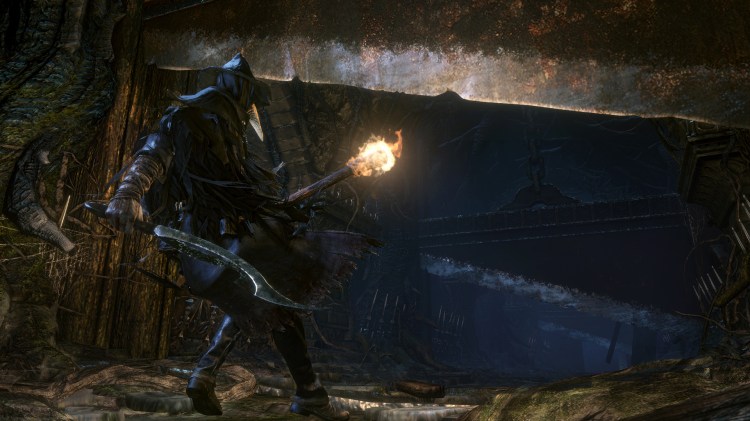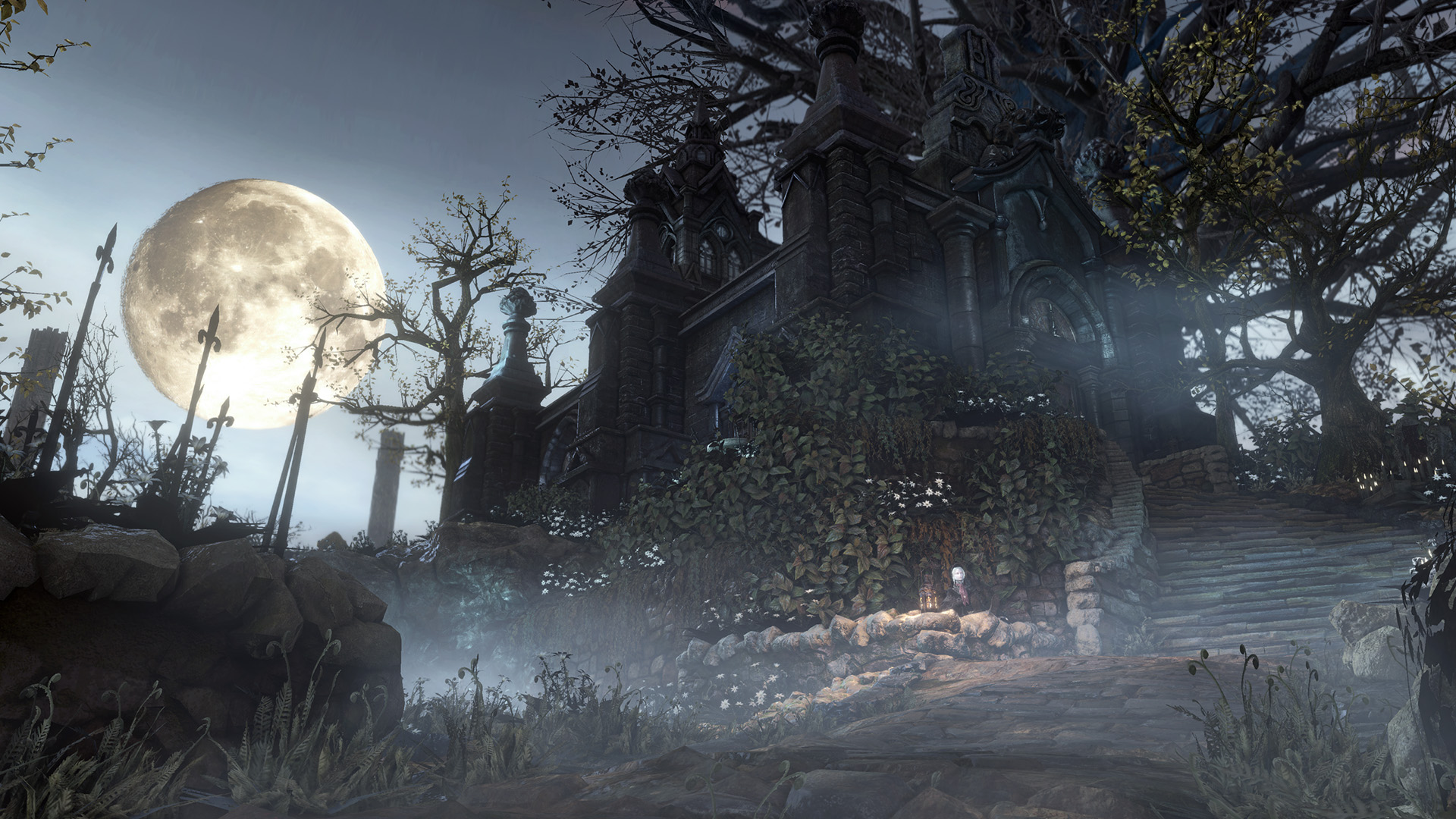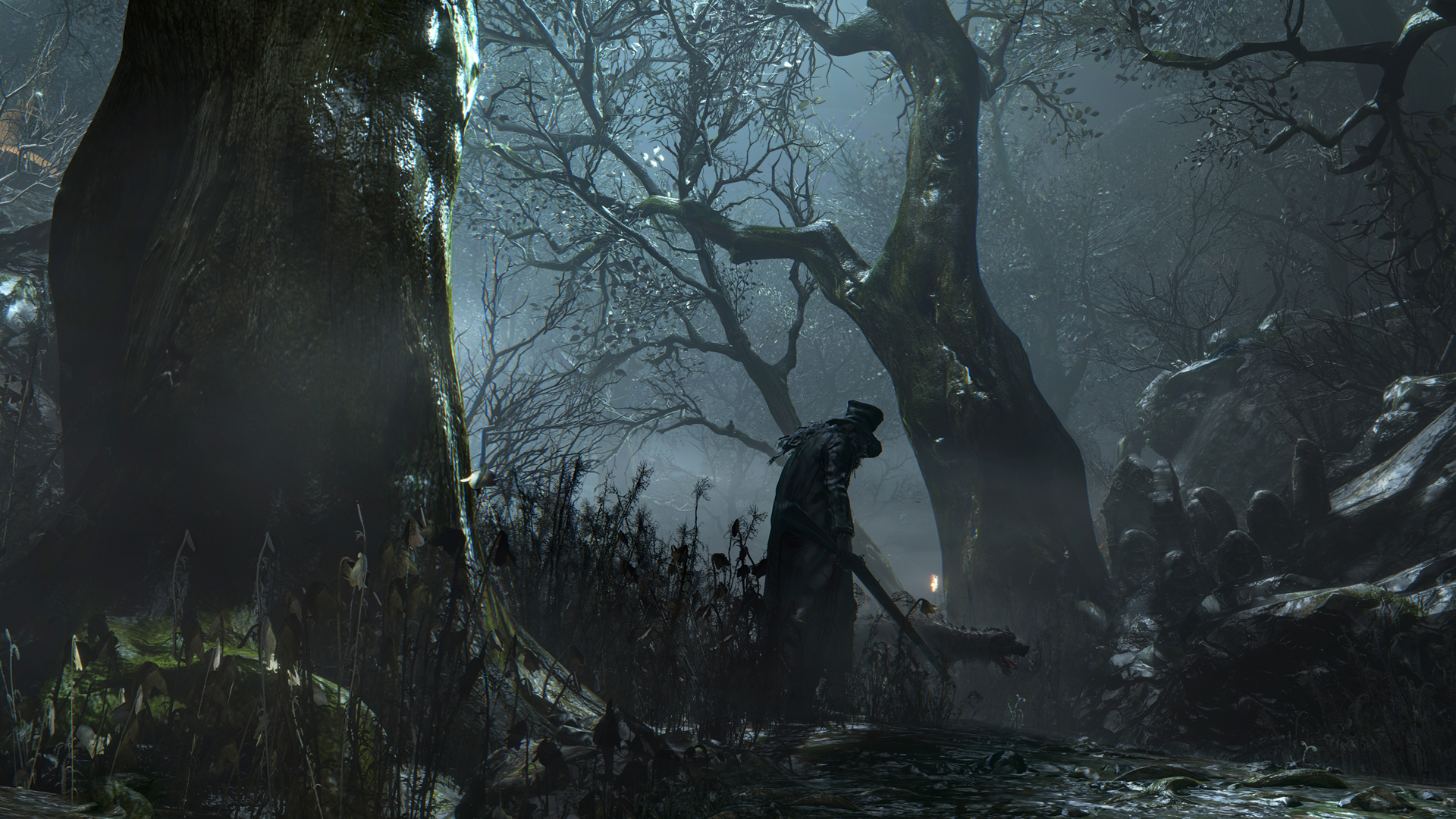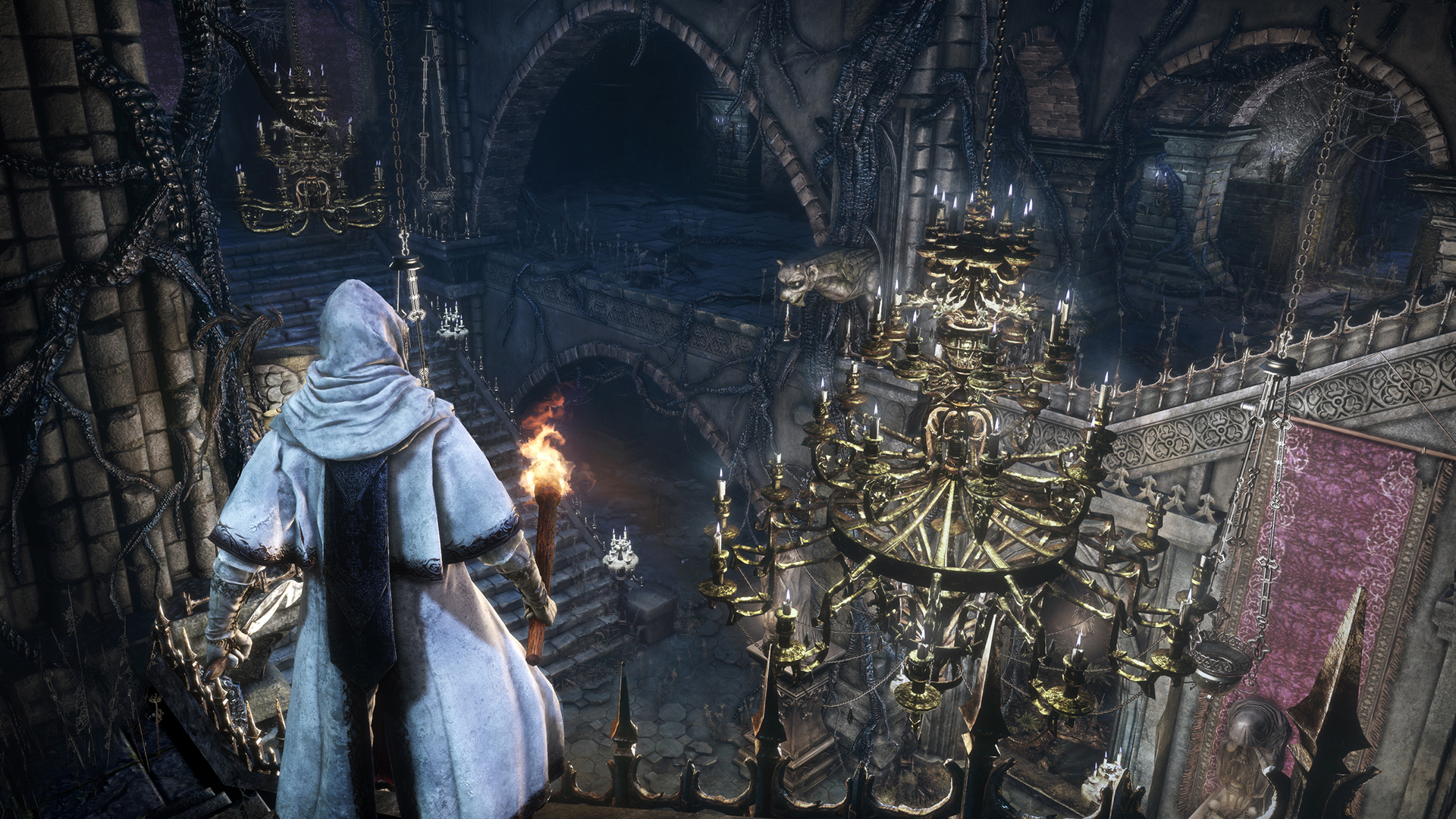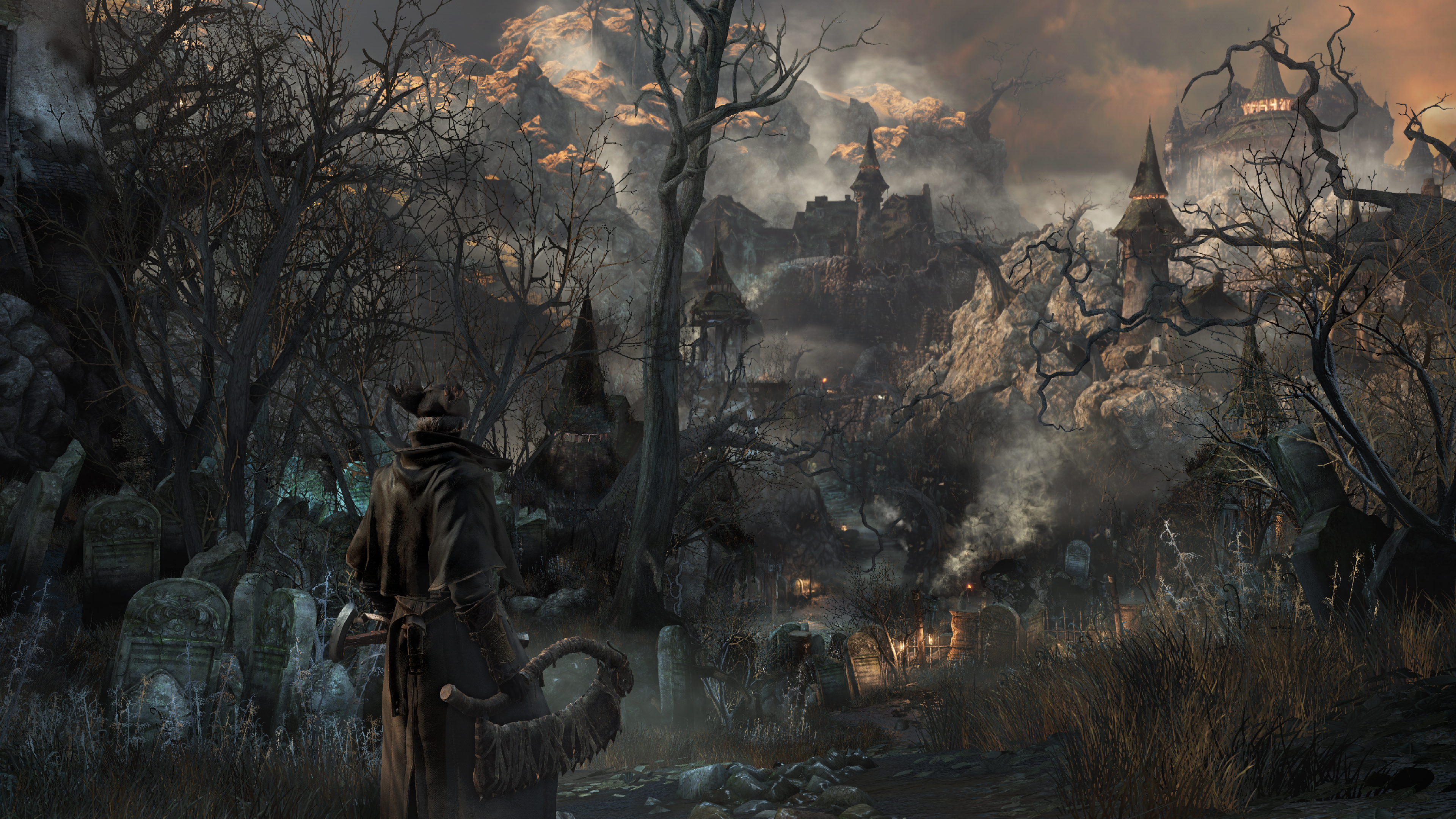Updated at 2:24 p.m. Pacific on Sunday, March 29, to reflect that the review is now final, not a review in progress –Ed.
Check out our Reviews Vault for past game reviews.
The era of souls is over. The era of blood begins.
Don’t think that a second name change has slowed or softened From Software. What began in Demon’s Souls and passed into Dark Souls now continues in the PlayStation 4 exclusive Bloodborne. Demon’s and Dark Souls director Hidetaka Miyazaki is in charge again after stepping down to merely supervise Dark Souls II. He and the From Software team have taken their dangerously precise action-RPG formula from the medieval to the Industrial Age.
But is this gruesomely macabre world worth dying again and again for?
What you’ll like
Stories that you earn
The Souls’ designers figured out something that most developers still don’t grasp: that even within the same game, you find multiple kinds of players. For action-heavy games especially, plot and narrative don’t hold the same weight for everyone who plays. Some are out there to find out about the world around them, and others want to fire a portable canon at werewolves for a couple dozen hours. Bloodborne excels — even more so than its Souls cousins — at letting each subset play to their desires without configuring their tastes in menus before starting.
Story in Bloodborne, between extremely vague cutscenes, exists on the periphery. You are a person who recently received a blood transfusion from a nebulous-looking old man before demons mauled you, and you woke up to words like “paleblood” and “the Hunt.” The intriguing tale of a church ritually staving off the recurring menace of something known as the Vilebloods is then yours to discover, largely through environmental clues and even item descriptions. No one knows that boss you just killed, neither the dutiful scholar nor the hack-and-slasher, but the opportunity to discover their context is open to all to explore.
A diverse and ornately designed universe
Bloodborne doesn’t leave your head. Some of this is about going over possible strategies for fighting the latest boss in your head before going to bed. Most of it has to do with how little you can get over how stunning everything looks. Your playthrough will take you through every district in an increasingly paranoid town, crumbling churches, and darkened forests, each packed with detail and brought to shifting life by vivid atmospheric lighting.
But beauty does not always have to be aesthetically pleasing. While the densely clustered cobblestone streets of the central city have a melancholy gleam once the fog rolls in, the true beauty of Bloodborne is in the grotesque and bizarre. The further you venture into the city of Yharnam and its surrounding frontier, the more you flirt with the creatures of cosmic horror.
You will occasionally encounter familiar-looking villagers in multiple realms and watch them gradually grow more feral and touched by the supernatural. Some become lycanthropic, growing three feet and sprouting canine jaws dripping with viscera. Other humans will reappear later on with bandaged heads, and it will only be right before they attack you that a dozen prehensile snakes will erupt from their craniums.
From Software must have some morbid artists on its team, because these abominations are where Bloodborne’s art direction shines brightest. The most microscopic details, like the way an indescribable gelatinous mass sloshes its way along the cave ground toward you or the unique crackle a crucified corpse makes while burning, manage to unnerve and discomfort. I would call it a feast for the senses if any of it looked at all appetizing.
Combat that forces you to take the offensive
The wait-and-strike approach of Souls past work won’t here. Combat in Bloodborne is an immediate, bloody duel between you and every single enemy you come across. Enemies will only get more aggressive as the night wears on; your hunter will have to take the initiative if they expect to survive the cryptic and all-consuming Hunt.
To that end, you possess a smaller but more malleable arsenal than in previous Souls. You can equip a melee weapon and a firearm, the former being able to transform between close and long-range states. An unsheathed longsword used for crowd control, for example, can slide back into the sheath to form a blunt greatsword for heavier damage. This, combined with the variety of collectible bloodgems that add various status effects to your chosen weapon, keeps things from feeling comparatively stale.
The Regain System holds combat together. Upon taking most hits, your health meter depletes, but with a caveat. If you are able to follow through and land a blow on your opponent within the next split second, you can replenish part of your lost health. Follow through with enough connecting blows, and that mace hit that took you down by half of your hit points only ends up taking a sliver. While you take a Blood Vial to regain your health the old-fashion way, the Regain System adds an additional layer of risky, addicting strategy to already hectic battles.
Eviscerating with friends
One of the most common messages you will find (as a huddle of childlike messenger demons proudly presenting it to you from a burbling portal in the ground) is “A Hunter is Never Alone.” You don’t need to be in an active co-op or player-vs.-player session to gain the benefits of the greater Bloodborne community. As in the Souls games, any hunter could leave a message anywhere on the ground. Receiving a positive “Fine” vote from another player on a message you wrote even heals your character should you be online at the time of rating.
The mistakes of others are also forever scared onto the earth, in popping blood pools that hide an eerie headstone. Activating those pools plays back the last 10 seconds of a player’s life, a red-outlined specter of their hunter rolling around in a doomed bid for life. Even without clicking on each and every message strewn along the ground, their presence subtly foreshadows secrets or dangers. A few notes lying next to a wall may mark the presence of a slyly concealed path, and a ton of blood pools along a seemingly innocent road tell you a trap may be waiting.
Actually playing with friends only adds to the tension of combat and exploration, and it becomes essential after the middle portion of the adventure. Ringing a series of bells summons a random player to battle with or against you — or opens yourself to a potential summoning. You will celebrate the appearance of a blue-tinted hunter appearing in your world with the same aplomb in the 50th hour as you in the fifth.
What you won’t like
Escalating, continuous performance issues
With the sheer amount of content on display in Bloodborne, some hiccups are inevitable. My playthrough is littered with textures popping in and out of existence, clothing and grass clipping through anything and everything, and the sky consistently cracking through buildings in the far distance. The aesthetic package overall does remains solid, if a bit more jarring than average given the game’s immersive aspirations. From Software did note that they expected graphical issues in the prerelease build, but I saw no positive change following my download of the day one patch.
If the extent of the performance issues remained on the surface, I wouldn’t even be speaking of them. Even the framerate slow downs or outright, microsecond freezes were within the margin of acceptable error. But those same hiccups did have a tendency to turn deadly. Locking on enemies is near impossible when you are around the slightest corner of a building or tree, which is especially harsh given their innate ability to hit you through solid matter. My hunter got trapped in an outcropping of rocks or tall weeds more frequently as my playthrough progressed, getting dislodged only when hit with an enemy attack. I expect to die a lot in these games but not speared by a giant pig because my leg was halfway inside a boulder.
Players have been issuing a multitude of viable bug and glitch complaints since Bloodborne’s launch. Some are even as bad as an entire NPC’s questline breaking after the first encounter.
And while playing with friends can often be the best part of the experience, actually managing to begin a multiplayer session often requires inhuman levels of patience. At the time of this update, I have attempted to summon other players for help 22 times, and I offered my assistance to other hunters four times. I successfully bridged between two worlds a total of 10 times between all attempts, with an average wait time of 12 minutes. I tried this at all times of day and at multiple points in the game. Thankfully, once a session started, I encountered no latency or gameplay issues.
But all that was nothing compared to trying to begin a dedicated session between myself and a specific friend. It took five attempts with an average wait time of 2 minutes to get one going, even when we were standing in the exact same area in the exact same map, passwords and matchmaking regions correct, characters within the appropriate range of +/- 10 levels of each other, and with stable Internet connections. These hoops feel like a concession made to players by a company more inclined to keep multiplayer mysterious, and if that is the case, they shouldn’t have even bothered to implement it.
Even still, you will encounter the greatest enemy in Bloodborne early and often: the load times. Stretching from 10 seconds to almost a full 60 seconds, these are unacceptable lengths to sit before a mockingly blank black screen with the logo of the game you desperately want to get back into. The inability to warp between lanterns, instead having to travel to and from the Hunter’s Dream hub world for an extra 30 seconds to 55 seconds of loading, makes this even more agonizing.
Boss recycling
It can be a thrill to see the enemies in an area gradually grow stronger as you level up your hunter. Monsters that wielded scythes when you were level 25 will have electrified their weapons when you return at level 30. Watching the game essentially keep up with your progress is exciting, but only when you do not feel that you are staring at the same exact encounter, modified just enough to justify copying it back in. Some tiny variations existed between between the three giant dog bosses I went up against in the first third of my playthrough, but it still felt like I was fighting a lightning dog with the same three-swipe/leaping/elemental-area-of-attack pattern as the giant fire dog and giant praying dog I vanquished earlier.
You thankfully don’t need to defeat all bosses to progress, but that just makes the reused assets less necessary in the first place. It took me almost 20 hours to even engage a mechanically interesting boss, one where I couldn’t just roll around them and pick at their health until they died. These grand encounters in the games’ opening hours disappoint even without the pedigree of Bloodborne’s spiritual predecessors, and feel like exercises in the classic gameplay tactic of beefing up a normal enemy in size and damage.
The useless monotony of Chalice Dungeons
Nothing beats the Chalice Dungeons when it comes to cheap recycling. In theory, these are the smartest addition to the Souls’ gameplay formula. They are a series of customizable, wholly separate areas that players can build from items they gather, and they’re largely focused on co-op exploration. In practice, these feel like a last-minute addition vomited up to appease a marketing team.
You create a Chalice Dungeon by acquiring a chalice in one of a handful of varieties, combining it with a few other ritualistic or arcane items at a series of headstones in the Hunter’s Dream. But it just takes getting two layers deep into one of these dungeons to begin recognizing the same giant rooms and enemy configurations. Even the objectives remain the same tedious chores throughout each one, largely having to deal with fighting your way to a level to open the one door to the boss and the ladder down to the next layer. And that’s if you don’t get lost after forgetting how this layer connects the same grand ballroom to the same four hallways.
Each largely reuses the same materials. So for the handful of available Chalices of a certain type, for example, you are really only dealing with one type of dungeon with the same enemies; the only difference is that these foes are harder to kill. These dungeons could have been a great ease-of-entry point for new players. They condense the Bloodborne routine of exploration, traps, and preparing for boss encounters down to a miniature scale quite successfully. But the materials to craft them are so rarely found and so expensive that by the time you have amassed enough to begin dungeon-diving, you are too experienced to need them and too high level to get anything of valuable out of them.
The only thing Chalice Dungeons have going for them is that they’re optional.
Conclusion
Bloodborne is the system seller for all dedicated gamers that don’t already own a PS4.
Granted, From Software will need to issue some serious rapid-fire patching in order to make sure no one quits in frustration after being stuck-in-grass-to-death. And Bloodbourne suffers from the most tedious form of multiplayer yet seen in the Souls brand. Waiting for a match to begin initially feels like a punishment from a game mocking your need for help, and this then just dissolves into a boiling cauldron of impatient rage.
But the majority of Bloodborne’s faults can be literally ignored without the smallest consequence, save for the most masochistic of completionists. The wait-for-the-weakpoint approach we all have fallen into it since Demon’s Souls is no more, replaced with an arguably superior make-your-own-weakpoint system of offensive risk. But what will make Bloodborne a lasting triumph is the almost gleefully nightmarish world it is too keen to force-feed you to.
Score: 88/100
Bloodborne releases on March 24, exclusively on PS4. GamesBeat was provided a retail disc copy of the game for the purposes of this review.
VentureBeat's mission is to be a digital town square for technical decision-makers to gain knowledge about transformative enterprise technology and transact. Learn More
